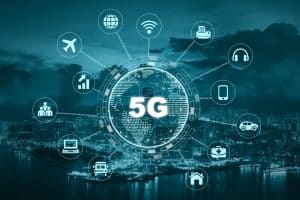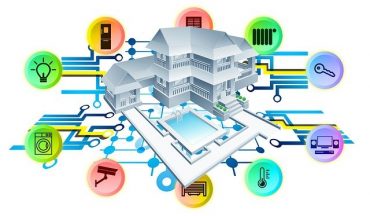
By integrating the 5G and IoT network, it will be feasible for the manufacturers to operate with comprehensive flexibility and move ahead to a dynamic ecosystem of suppliers and consumers.
There is no doubt that 5G mobile networks will turn out to be a huge leap when it comes to mobile broadband. IoT provides many advantages for 5G in healthcare, education, energy, and transportation. According to recent research, around 500 billion IoT tools, including sensors, medical devices, and actuators, will be connecting with the Internet.
These IoT devices will collect, aggregate, and analyze the data across many platforms and services. Therefore, 5G networks will be imperative for satisfying the demands of these types of data-intensive IoT devices.
The focus of the researchers has been on the impact made by the combination of IoT with 5G on our society as well as its cost facet. 5G’s introduction will bring modernization in the industries and offer emerging technologies such as IoT for unleashing their full potential.
According to the most recent mobility report by Ericsson AB, there will be around 600 million 5G subscriptions by next year. At the same time, the Asia-Pacific will be the second-fastest developing region, with approximately 10% of the total subscriptions being 5G.
See also: 5G and the Manufacturing Edge: Optimism Tempered
Advantages of 5G with IoT
It is a fact that 5G networks are quite fast and dependable thanks to fiber-optic cable, and therefore, they are going to provide speed, efficiency, security, latency, and reliability. Consequently, it will offer more flexibility and the same capacity at a lower price. The introduction of 5G will result in the improvement of mobile broadband services. Digital abilities based on virtual reality, autonomous operations, AI, and drones will be among those solutions that will have 5G networks for enhanced productivity and efficiency.
IoT is being adopted rapidly, and we can predict more investment in IoT gadgets in less than five years. It is possible to generate profits in IoT devices that entice manufacturers, for instance, reduced machine downtime, better product quality, predictive maintenance, and informed decision-making. Several restrictions that exist presently in IoT will be removed by 5G thanks to wireless technologies, which will not get rid of problems like vibration, sound, heat, and so on.
Watch Now: Dell Technologies Edge Solutions (Video)A connected effort
IoT merchants are currently focusing on fulfilling the precise and practical requirements of the industry and providing more dependable solutions catering to the demands of their clients. Furthermore, with the introduction of 5G networks, it will be possible for IoT platforms to connect to discrete solutions and point sensors for monitoring the entire process from research and development to the very conclusion of the product’s development cycle.
IoT and 5G will play an important part in creating an integrated ecosystem for optimizing manufacturing, distribution, and a product-consumption lifecycle. It will be feasible for the industries to connect to each stage continuously, from planning to the sales process. Furthermore, the data can be verified by analysts and decision-makers from the sensors set up throughout the proceedings of the manufacturers’ supplies and their consumers.
Data will flow backward and forward throughout the multidimensional ecosystem instead of flowing in a straight line anymore. Therefore, the ecosystem will allow a fast response to possible variations and disruptions in the demands of the consumers. IoT devices will enable us to obtain large amounts of data. This will prove to be a blessing for analytics since they will be able to take preventive planning and maintenance for renovating their products in such situations.
The ecosystem created by 5G and IoT together will introduce an era of smart manufacturing since it will be possible to optimize customizable products and manufacturing procedures.
What has been found by research on 5G and IoT
- Machines equipped with 5G and IoT represent a global opportunity of $1.2B by 2024.
- 5G is imperative for in-building private wireless networks for supporting dependable IoT applications.
- Application revenue for edge computing in 5G will be increasing by 40% of the total infrastructure spending by 2024.
- The biggest industrial vertical intended for MEC is going to be manufactured by 2024. It will be propelled by private LTE and 5G networks for the industrial segment.
- IoT networks will be optimized by 5G through the usage of radiofrequency management to satisfy the demands of narrowband IoT applications and those requiring higher bandwidth.
- IoT solutions will benefit from the implementation of 5G because of the arrangement of low-power WAN IoT network capacities.
- IoT’s scope will go on increasing when it comes to the impact made by it on the daily lives of the customers as well as enterprise systems.
Improvement in mobility
Let us take an example right here. Employees who have been provided with augmented VR/AR headsets will be able to move freely in the factory, and they are going to be connected to the 5G network constantly. It will be possible for these workers to simulate each process in three dimensions up to the final product while interacting with IoT devices.
The capability of VR/AR to detect glitches using simulations happens to be amongst the most invaluable properties of this particular system. Moreover, 5G networks can be integrated by these industries into their digital strategy using network slicing. Apart from this, it will allow the integration of merchants and consumers into the platform. Thus, it will be possible to achieve the industrial revolution 4.0 with the help of the combination of IoT with 5G.
It will not be imperative for the manufacturers to depend on fixed and mobile networks for their communication requirements. Mobility will be required for flexible manufacturing, which 5G can provide. It will be possible for industries to move on from a Wi-Fi network that is not reliable.
5G network options
Industries prefer their digital transformation strategy to be implemented by private networks. In this way, they will be able to use the combination of 5G and IoT.
There are a couple of choices for a private network: work with a telecommunications provider that already exists for operating the entire system or create a system that they can run independently.
Governments are currently focusing on opening more 5G spectrum because of the competition for bandwidth amongst consumers, companies, and the public sector. Moreover, the 5G network is prone to become vulnerable to cyber-attacks. Therefore, we expect the manufacturers to get a powerful network security protocol with secure and innovative software algorithms and network slicing. Therefore, unlike the presently used infrastructure, a more powerful data security level will be offered by 5G.
The 5G-IoT future
By integrating the 5G and IoT network, it will be feasible for the manufacturers to operate with comprehensive flexibility and move ahead to a dynamic ecosystem of suppliers and consumers. Now it is up to the individuals to take full advantage of industrial revolution 4.0, which has taken a giant leap thanks to the integration of 5G and IoT.







